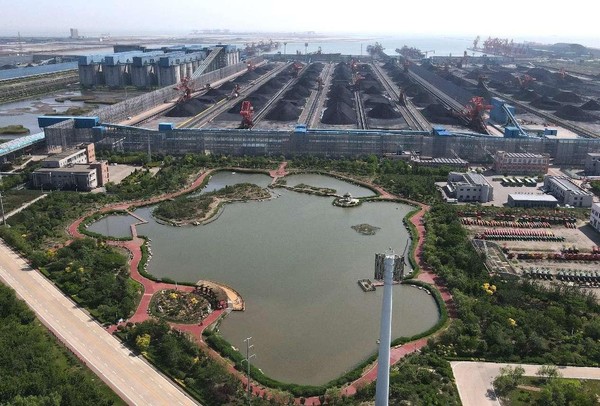By Yan Bing, Wang Shengying
Traditional sea ports across China are gradually turning into "ecological oases," applying intelligent technologies and implementing various pollution prevention and treatment measures.
For instance, the Huanghua port in north China's Hebei province, an important hub for the transportation of coal in China, has turned a construction waste dump into an artificial lake tanked up with purified coal sewage under comprehensive ecological environment management.

Each year, about 200 million tons of coal is shipped to other parts of China via the Huanghua port. However, coal ash is seldom seen in the work zone or the living quarters of the port despite the huge throughput. The port, clean and tidy, is embracing a green and eco-friendly transition.
This is attributed to efforts and innovations made over the years in improving dust suppression technology, water utilization and smart production.
According to Xu Ning, vice manager of the No.3 production department of the company that manages the Huanghua port, the company has independently developed a dust suppression technology that is able to effectively moisturize and attach dust particles when coal is handled by dumpers, realizing dust control in the whole process of stacking and loading operations during transportation.

Besides, the company has also developed a conveyor belt cleaner and other pollution treatment technologies, Xu said, adding that 98 percent of dust can be suppressed at construction sites.
Freshwater is extremely valuable for the Huanghua port, which is located on saline-alkali fields. The higher requirement for environmental protection once led to a surge in freshwater consumption at the port.
To tackle the freshwater shortage, the Huanghua port recycles ballast water, purifies coal sewage and collects rainwater into its artificial lakes and wetlands. Now, over 90 percent of the freshwater consumed by the port is produced by the port itself, which saves it over 19 million yuan ($2.65 million) each year and makes its production greener.

The Caofeidian port, which is also a major hub for coal transportation in Hebei province, is also committed to green development. The port has built a 400,000-ton coal storage yard where over 99 percent of static dust emission can be suppressed.
To better reduce dust pollution in the port's surrounding areas and sea waters, the company managing the Caofeidian port has built huge windbreak netting near the coal storage yard.
If the yard is fully enclosed by the windbreak netting, the total dust volume would be reduced by another 80 percent from the current level, and the environmental impacts from the dust on areas within 5 kilometers from the yard would be lowered by more than 70 percent, relevant personnel told People's Daily.
Intelligence also provides a key boost to the green and low-carbon development of ports across the country.
At an intelligent container terminal of the port of Tianjin in north China, 12 automatic ship-to-shore gantry cranes, 92 smart transport vehicles and 42 gantry cranes were running at full capacity, handling cargo from across the world. No manual work was observed at the terminal.
On the north end of the terminal, two wind turbines were rotating slowly, generating green electricity for production.
It is said that the terminal is the first one in the world that is entirely powered by green electricity and releases no carbon emissions. It is equipped with multiple wind turbines and a solar farm, which boasts the largest single-unit installed capacity among all solar farms built at ports across China.
Sun Biao, deputy general manager of Tianjin Port Group's No 2 Container Terminal, told People's Daily that 5G technology, Beidou Navigation Satellite System and AI have been massively applied in the operation of the terminal, and all procedures are controlled by a smart transport management system, marking the first in the world.
Sun noted that the terminal has offered Chinese plans for the intelligent upgrading and low-carbon development of other container terminals around the world.

